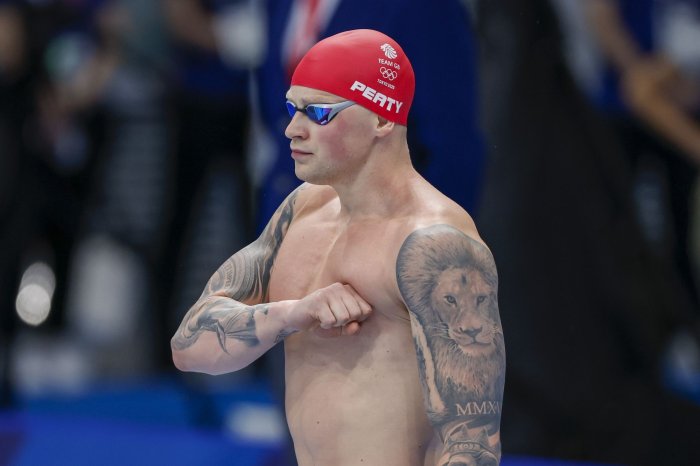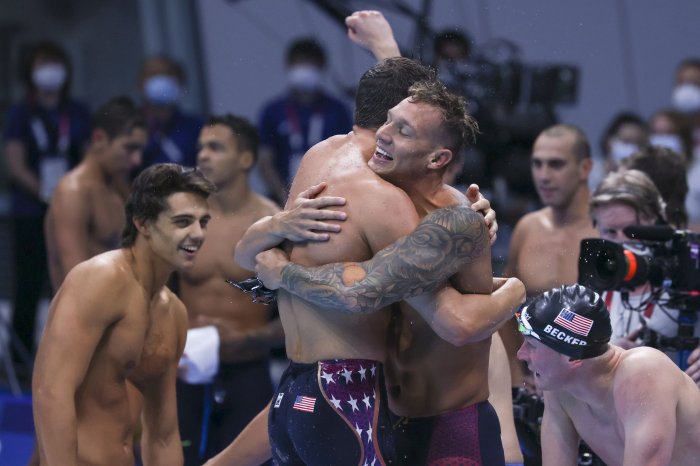
Gymnast Eleftherios Petrounias of Greece sports an Olympic tattoo on his back.
Photo by Richard Ellis/UPI | License Photo
July 26 (UPI) -- Tattoos are widely on display among athletes at the Tokyo 2020 Olympic Summer Games, despite the country's longstanding taboos against skin markings.
Japanese law forbids visible tattoos in public locations, such as bathhouses, saunas, public swimming pools, beaches, gyms and some restaurants, but ink has been on display without athletes being asked to cover up as the games have begun.
Swimmers Adam Peaty of Britain and Caeleb Dressel of the United States both don full-arm sleeves, while Team USA basketball stars Damian Lillard and Jayson Tatum have tattoos clearly visible from underneath their sleeveless jerseys.
Many Olympians also get tattoos of the Olympic rings, including swimmer Chase Kalisz of Team USA and gymnast Eleftherios Petrounias of Greece.
July 26 (UPI) -- Tattoos are widely on display among athletes at the Tokyo 2020 Olympic Summer Games, despite the country's longstanding taboos against skin markings.
Japanese law forbids visible tattoos in public locations, such as bathhouses, saunas, public swimming pools, beaches, gyms and some restaurants, but ink has been on display without athletes being asked to cover up as the games have begun.
Swimmers Adam Peaty of Britain and Caeleb Dressel of the United States both don full-arm sleeves, while Team USA basketball stars Damian Lillard and Jayson Tatum have tattoos clearly visible from underneath their sleeveless jerseys.
Many Olympians also get tattoos of the Olympic rings, including swimmer Chase Kalisz of Team USA and gymnast Eleftherios Petrounias of Greece.
The taboo surrounding tattoos may have been lessened because of the absence of spectators in the stands as a result of the COVID-19 pandemic. However, the country has raised the issue during past sporting events.
Ahead of the 2019 Rugby World Cup in Japan, New Zealand's All Blacks players volunteered to cover their tattoos in response to the social stigma.

British swimmer Adam Peaty shows ink on both arms.
Photo by Tasos Katopodis/UPI | License Photo
The stigma stems from an 18th-century practice in which the government tattooed the arms or foreheads of criminals to identify them. Over time, tattoos became associated with organized crime.
The stigma stems from an 18th-century practice in which the government tattooed the arms or foreheads of criminals to identify them. Over time, tattoos became associated with organized crime.
While public bans remain, a landmark ruling by Japan's Supreme Court in 2019 favored tattoo artists in declaring that tattooing someone without a medical license is not a violation of medical practitioners' law.

American swimmer Caeleb Dressel, with a full-sleeve tattoo, celebrates after winning the men's 4x100-meter freestyle relay. Photo by Tasos Katopodis/UPI | License Photo

Some tattooed people who live in Japan gather for the annual meeting of the Irezumi Aikokai, or Tattoo Lovers Association, in Tokyo.
The group's head, Hiroyuki Nemoto, told the BBC the gathering is important because its members are most often forced to hide their tattoos from society.
"But just once a year, we can proudly show off our tattoos and show each other what new tattoos we've gotten," he said.

American swimmer Caeleb Dressel, with a full-sleeve tattoo, celebrates after winning the men's 4x100-meter freestyle relay. Photo by Tasos Katopodis/UPI | License Photo

Some tattooed people who live in Japan gather for the annual meeting of the Irezumi Aikokai, or Tattoo Lovers Association, in Tokyo.
The group's head, Hiroyuki Nemoto, told the BBC the gathering is important because its members are most often forced to hide their tattoos from society.
"But just once a year, we can proudly show off our tattoos and show each other what new tattoos we've gotten," he said.
No comments:
Post a Comment